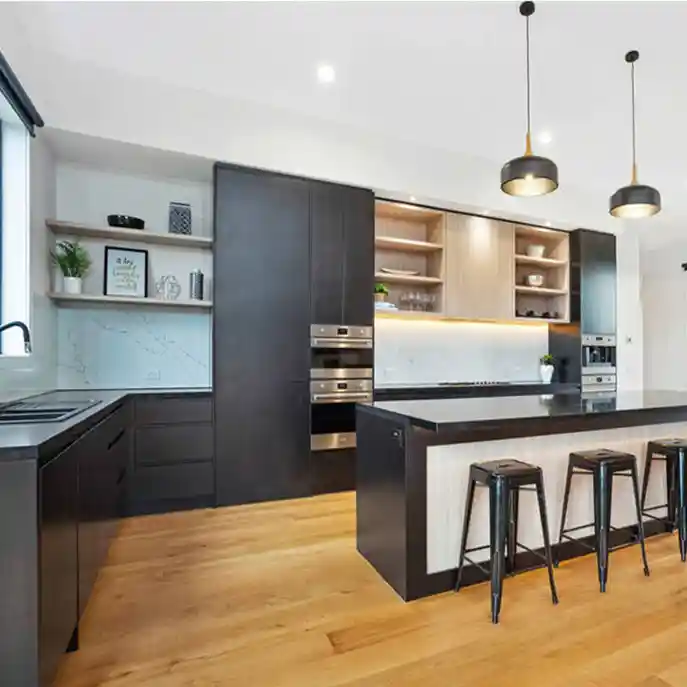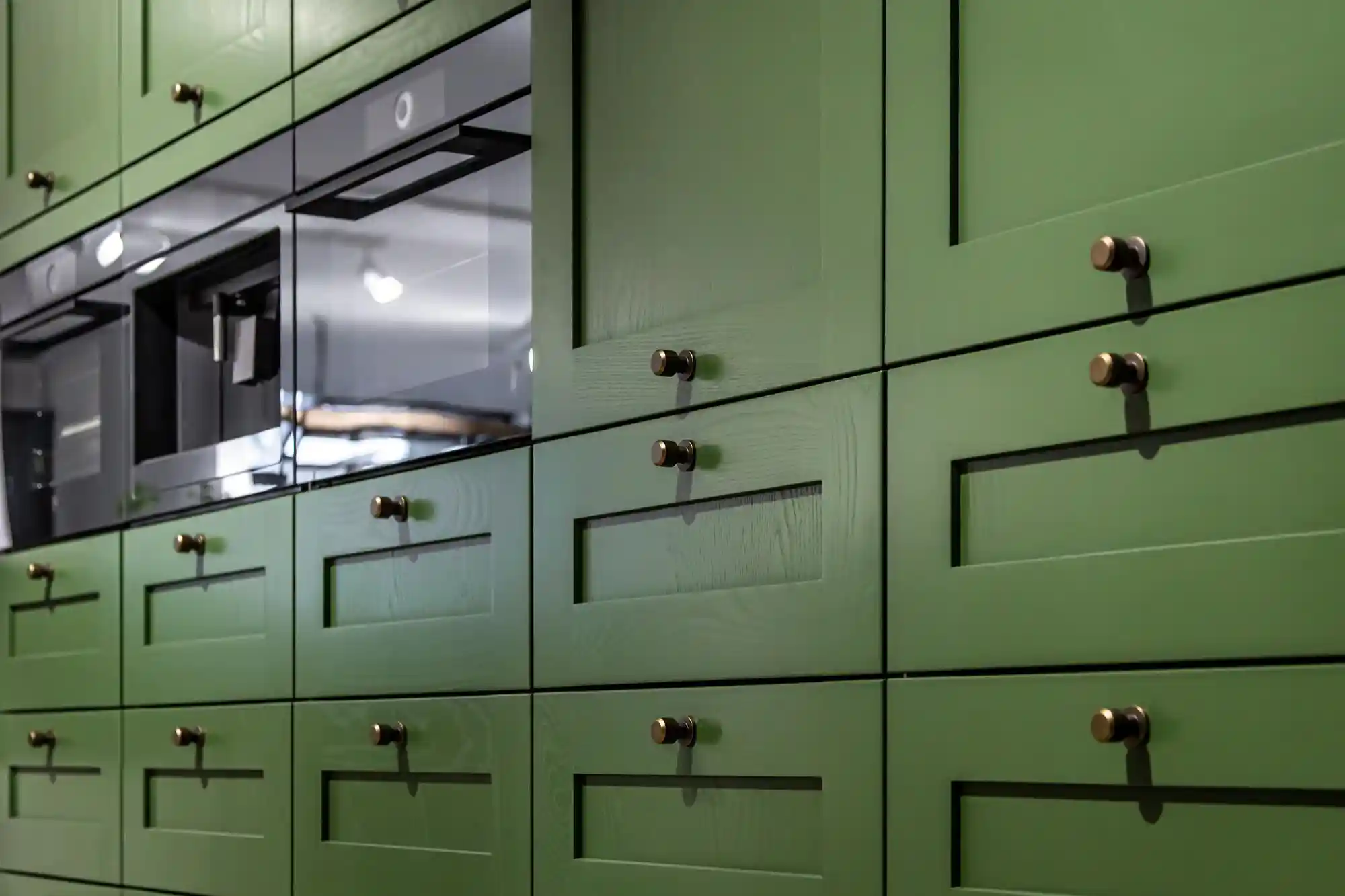Framed vs. Frameless Cabinets: Which Style Reigns Supreme in Your Kitchen?
When considering a kitchen renovation project, cabinets play a crucial role in shaping both the aesthetics and practicality of your kitchen space. The selection between frameless cabinets stands out as a significant decision among the array of options available. Let’s delve into the features as well as the advantages and disadvantages of each style to assist you in making an informed choice.

The Great Cabinetry Debate: Framed vs. Frameless
It’s important to grasp the distinctions between framed and frameless cabinets as they embody different methods of cabinet building with their advantages and disadvantages to consider carefully. Exploring the aspects of each style can provide valuable knowledge to help you make an informed decision that suits your space perfectly.
What’s the Deal with Framed Cabinets?
Traditional American cabinet makers often use framed cabinetry as their go-to method of construction—a style commonly found in kitchens you may have come across before. Framed cabinets are characterized by a 1 1/2 inch frame at the front that gives them the appearance of a picture frame before attaching the cabinet doors onto this structure.
- This construction gives the cabinets a sturdier buildsince the doors are secured to the frame.
- Framed cabinets can be made with the frames cut from one solid piece of wood, allowing for various arrangements of drawers and doors.
- This traditional approach also offers a certain aesthetic appeal that many homeowners appreciate.
The Appeal of Frameless Cabinets
European-inspired frameless cabinets offer a modern twist on cabinet construction that has gained popularity in American kitchens due to its stylish design and convenient full-access features – the key idea being the removal of the face frame to leave just the box structure.
- The doors are then attached directly to the sides of the cabinet box, creating a clean, modern look.
- Without the frame, the cabinet box needs to be thicker to provide adequate strength and stability.
- Frameless cabinets are sometimes called “full access” because they allow more accessibility by removing the frame and the center stiles between two cabinet doors.
Comparing the Core Characteristics
When you look past the building variances between them, you’ll see that framed and frameless cabinets have distinct variations, in design, storage space, installation methods, and upkeep requirements. These differences can greatly influence both the functionality and appearance of your kitchen. It’s important to grasp these distinctions as you weigh which cabinet style suits your requirements and tastes best.
Design and Customization
In terms of design and personalization options for framed cabinets are quite extensive and versatile. Framed cabinets allow for the creation of an appearance by installing the doors within the frame (full overlay) or showcasing a portion of the frame by attaching the doors to the front of it (partial overlay). The adaptability of framed cabinets simplifies the process of achieving an aesthetic for your kitchen.
- You have the freedom to select various door styles and arrangements, making it a versatile choice for different design aesthetics.
- Framed cabinets can be designed to fit almost any aesthetic, from traditional to contemporary.
Frameless cabinets have a minimalistic design compared to their counterparts with face frames that give them a clean and smooth look.
- The doors are typically full overlay, covering the entire cabinet cavity.
- This style often features clean lines and high gloss finishes, which is well-suited for contemporary and minimalist kitchen designs.
- While the design options aren’t as varied as framed cabinets, they bring a sense of modern sophistication.
To sum it up; if you prefer having a range of choices and design flexibility in mind; framed cabinets might be your go-to option. On the other hand; if you are after a contemporary and polished appearance; frameless cabinets could be more appealing to you. Framed cabinets provide opportunities for customizing the design whereas frameless cabinets are commonly selected for their smooth contours and shiny finishes.
Space and Accessibility
There are differences in storage space and accessibility between framed and frameless cabinets. The traditional design of framed cabinets can sometimes lead to issues with space availability.
- The face frame can limit access to the interior of the cabinet, and you might find that drawers are smaller than the cabinet opening.
- The frame takes up space, potentially reducing the amount of usable storage.
- With partial overlay designs, a center rail can also interfere with the accessibility of the cabinet.
Frameless cabinets are recognized for their ability to optimize storage capacity by offering accessibility to the cabinet interior without any obstructions.
- Because there is no frame, drawers and cabinet spacetend to be larger, allowing you to store more items.
- With frameless cabinets, there are no center stilesto get in the way.
- Frameless cabinets maximize storage capacitybecause the drawers take up the full space.
In a nutshell; although the shelf space might seem comparable at a glance; it’s important to note that framed cabinets tend to have narrower drawer openings compared to frameless cabinets that make the most of storage capacity.
Construction and Installation
The construction of frameless cabinets plays a significant role in how they are installed – framed cabinets are durable due to the extra support provided by the face frame layer.
- Because of the frame, they are generally easier to install. The frame helps with alignment and provides a secure base for attaching the doors and drawers.
- This type of construction makes framed cabinets a suitable choice for beginners in craftsmanship.
Installing cabinets demands a meticulous and skilled technique for precision as they depend on the thickness of the cabinet box for their structural integrity due to the absence of a face frame.
- They can be more difficult to install and are more likely to get twisted out of alignment during the installation process.
- If not correctly installed, frameless cabinets can have problems such as misaligned doors and drawers that do not pull out smoothly.
- Their strength and functionality depend on accurate installation.
In summary; framed cabinets are robust thanks to the frame and simpler for beginners to install compared to frameless cabinets that demand precise skills for installation by experts. Framed cabinets offer alignment during installation due to the presence of a face frame.
Maintenance and Durability
Maintaining cabinets is pretty simple as they usually don’t need much upkeep apart from regular cleaning routines.
- You might need to wipe them down occasionally to remove dust or spills.
- However, dust and dirt can accumulate along the edges of the face frame.
Frameless cabinets might demand a bit of care in comparison to other types of cabinets as they often require frequent adjustments of the door hinges.
- Humidity can affect the alignment of frameless cabinets, causing the doors to shift, swell, or shrink.
- You may need to adjust the hinges a couple of times a year so they line up properly.
When it comes to durability both kinds of cabinets can last a time but how long they endure relies on the quality of materials and craftsmanship.
Simply put cabinets with frames need little upkeep while frameless ones might require occasional hinge tweaks. Their durability relies on their quality. Build.
Cost and Timeline
When choosing between frameless cabinets it’s important to consider both the cost and installation timeline factors into your decision-making process as they play a practical role in your decision-making process.
- The materials and construction are usually less complex, which can make them more affordable.
- Installationof framed cabinets tends to be faster, taking approximately 2-3 days.
Frameless cabinets may come with an initial price due to their complex design and more involved installation process.
- The added labor and precision required for their installation often contribute to the higher price.
- Installationis typically more time-consuming and can take 5 or more days to complete.
In short; framed cabinets are typically cheaper and quicker to install compared to cabinets which come with a higher initial cost and require more time for installation due to the labor involved in setting them up.

Making the Choice: Which Cabinet Style Suits You Best?
After gaining insight into the distinctions between frameless cabinets in-depth you can assess which style best suits your requirements. Your decision should harmonize with the design, functionality, and financial considerations of your kitchen.
When to Choose Framed Cabinets
Framed cabinets work well in scenarios and are particularly suitable if you prefer a classic aesthetic for your kitchen space.
- If you are someone who values a wide range of design options, framed cabinets allow you to customize the look of your kitchen with door styles and overlays.
- If your kitchen is largewith lots of cabinet space, the space limitations of framed cabinets are not likely to be a concern.
- They are also the better choice if you are budget-consciousand need a less expensive option.
- If you want stability and strengthin your cabinetry, framed cabinets provide a solid, sturdy construction.
- Also, if you prefer minimal maintenance, framed cabinets are easier to care for.
When to Choose Frameless Cabinets
If you’re into a sleek kitchen style, that’s all about minimalism and clean lines. Go for frameless cabinets! They can spruce up any kitchen with their sleek design.
- If you have a smaller kitchenand want to maximize space, frameless cabinets offer more interior space and storage.
- Also, if you want full accessto cabinet interiors without the obstruction of a face frame, then frameless cabinets are a better option.
- If you are seeking more drawer and cabinet space, frameless cabinets tend to provide more storage.
- If you are okay with a higher cost and maintenance, you might enjoy the benefits of frameless cabinets. The higher price is justified by the modern look and full access.
Refor Furniture: Your Reliable Kitchen Cabinet Partner
When exploring the realm of kitchen cabinets, it’s good to know that there are suppliers available who can offer you the choices you seek with reliability and top-notch service in mind. Refor Furniture stands out as a go-to specialist in tailor-made space solutions with over 15 years of business expertise. They concentrate on delivering goods and services aimed at enhancing living environments.
- They provide personalized designsand high-quality workmanship, conforming to European and USA standards.
- They offer a variety of kitchen cabinet styles, materials, and finishes, including modern, shaker, and traditional designs.
- Refor uses top-brand hardwaresuch as Blum, Hafele, and DTC, ensuring quality and durability.
- They offer various materials including melamine, lacquer, solid wood, and PVC.
- Refor provides free design services and itemized quotations.
- They have a professionalteam and QC control and provide comprehensive quality inspection of furniture before delivery.
Conclusion
Deciding between frameless cabinets isn’t a straightforward choice to make for everyone; each style offers distinct features that appeal to various tastes and requirements. Taking the time to assess your priorities will help you determine the suitable option for your needs. Your kitchen serves as a hub in your home; therefore selecting the perfect cabinets can significantly enhance the overall experience. To create a kitchen that perfectly suits your needs and improves your daily life experience it’s important to weigh the advantages and disadvantages of frameless cabinets while selecting a reliable partner such as Refor Furniture.






